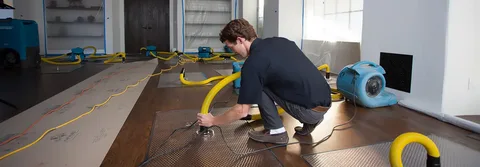
Water damage can turn your home into a disaster zone in no time. Whether it’s from a burst pipe, flooding, or a leaking roof, knowing how to handle the situation quickly is crucial. But should you take the DIY route or call professionals like Flood Express? The answer depends on several factors, including the severity of the damage, costs, and your expertise. Let’s dive deep into both options so you can make the right choice.
Understanding Water Damage
Water damage comes in different forms, from minor leaks to major flooding. The severity is usually categorized into three types:
-
Category 1: Clean water from sources like broken pipes or rainwater.
-
Category 2: Grey water from appliances or sump pumps, which may contain contaminants.
-
Category 3: Black water from sewage backups or floodwater, which is highly hazardous.
The type and extent of water damage play a crucial role in deciding whether to go DIY or hire professionals.
DIY Water Damage Restoration: Pros and Cons
If you’re dealing with minor water damage, a DIY approach might seem tempting. Here’s what you need to know:
Pros of DIY Water Damage Restoration
-
Cost Savings – Professional services can be expensive. A DIY approach can save you money on labor costs.
-
Immediate Action – You don’t have to wait for professionals to arrive. Acting fast can prevent further damage.
-
Control Over Process – You can decide how and when to handle the restoration.
Cons of DIY Water Damage Restoration
-
Limited Equipment – Professionals use industrial-grade dehumidifiers, moisture meters, and air movers, which are often not accessible to homeowners.
-
Hidden Damage Risks – Water can seep into walls, flooring, and ceilings, causing mold growth and structural damage that isn’t always visible.
-
Health Hazards – Mold and bacteria thrive in moisture-rich environments. Without proper protective gear, DIY restoration can pose serious health risks.
-
Insurance Issues – If the damage isn’t handled correctly, your insurance provider may not cover future issues.
When DIY Works Best
-
The damage is minimal (e.g., a small water spill that hasn’t soaked into walls or flooring).
-
The water source is clean (Category 1).
-
You have the right equipment, such as wet vacuums and fans.
-
You are knowledgeable about proper drying techniques.
Professional Water Damage Restoration: Pros and Cons
If your water damage situation is severe, calling professionals like Flood Express is a smart decision. Here’s why:
Pros of Professional Water Damage Restoration
-
Expertise & Experience – Professionals are trained to handle water damage efficiently, reducing the risk of long-term issues.
-
Advanced Equipment – High-powered dryers, air scrubbers, and moisture detectors ensure complete drying and mold prevention.
-
Faster Process – Experts can assess, clean, and restore your property much quicker than a DIY approach.
-
Mold Prevention – They apply antimicrobial treatments to prevent mold growth, which can be a serious health hazard.
-
Insurance Assistance – Many professionals help navigate insurance claims, ensuring you get the maximum coverage.
Cons of Professional Water Damage Restoration
-
Cost – Professional services can be pricey, but the cost is often justified by thorough damage mitigation and long-term savings.
-
Scheduling Delays – You may need to wait for an appointment, especially during peak flood seasons.
When Hiring Professionals is Essential
-
Water has soaked into walls, ceilings, or floors.
-
The damage is from grey or black water (Categories 2 & 3).
-
Mold is already visible or suspected.
-
There is a risk of structural damage.
-
You need help with insurance claims.
Real-Life Example: DIY vs. Professional Restoration
Imagine Sarah and Mike, both homeowners dealing with water damage. Sarah had a minor leak in her bathroom. She used a wet vacuum, ran fans for 48 hours, and kept an eye on moisture levels. She successfully managed her DIY restoration.
Mike, on the other hand, had a basement flood from a broken sump pump. He initially tried drying it out himself, but weeks later, he noticed a musty smell. Mold had spread behind the walls, leading to expensive remediation costs. Had he called Flood Express immediately, he could have avoided the extra expenses.
FAQs
1. How long does it take for water damage to cause mold?
Mold can start growing within 24-48 hours if moisture isn’t removed properly. Professional drying techniques significantly reduce this risk.
2. Can I just use a dehumidifier to dry out water damage?
A dehumidifier helps, but it’s not enough for severe water damage. Proper drying requires a combination of air movers, dehumidifiers, and moisture detection tools.
3. Will insurance cover water damage?
It depends on the cause. Insurance usually covers sudden and accidental damage (e.g., burst pipes) but may not cover flooding or gradual leaks.
4. How do I know if my walls are dry after water damage?
A moisture meter can help measure the water content in walls. Professionals use advanced tools to ensure complete dryness.
5. How much does professional water damage restoration cost?
Costs vary based on damage severity and location. On average, minor water damage restoration can range from $1,000 to $4,000, while severe damage may exceed $10,000.
Final Verdict: DIY or Professional Restoration?
If the water damage is minimal and you have the right tools, a DIY approach can work. However, for extensive damage, hidden moisture, or health risks, calling professionals like Flood Express ensures your home is restored safely and efficiently.
When in doubt, don’t risk long-term damage—consult with experts to protect your home and your health!